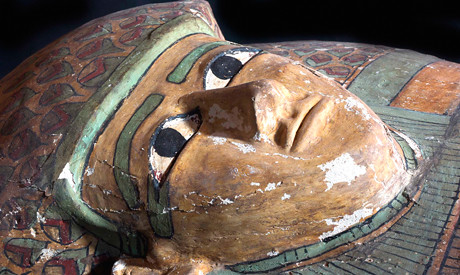
Wooden sarcophagus found with mummy inside from the 17th Dynasty some 3,600 years ago. Egypt is home the earliest world civilization. , a photo by Pan-African News Wire File Photos on Flickr.
Rare wooden anthropoid sarcophagus discovered in Luxor
Nevine El-Aref, Thursday 13 Feb 2014
A 17th dynasty painted sarcophagus belonging to a top governmental official was unearthed at Draa Abul-Naga necropolis on Luxor's west bank
A Spanish-Egyptian archeological team working on Luxor's west bank has discovered a rare wooden human-shaped sarcophagus from the 17th dynasty.
The find came during routine excavation work at the tomb of Djehuty, treasure holder for Queen Hatshepsut, at Dra Abul-Naga necropolis.
The sarcophagus is important for the detailed depictions of bird feather shapes and sizes painted on its lid, motifs that have earned it the title of Feathers Sarcophagi, according to Egypt's antiquities minister Mohamed Ibrahim.
The 2 metre long, 42 cm tall sarcophagus is in very good condition, Ibrahim said, and also engraved with titles of the deceased, which archeologists have not yet been able to identify.
Studies reveal that the sarcophagus belongs to a top governmental official from the 17th dynasty, whose mummy was enclosed inside, said Ibrahim.
The archeological team found two other burials at the site, which were both empty. It is believed that they were robbed in antiquity.
The Spanish mission began excavation work at Djehuty's tomb 13 years ago, when many artefacts from New Kingdom dynasties were found.
Last year the team unearthed a sarcophagus of a 17th dynasty child, along with a number of clay pots and ushabti figurines wrapped in linen.
Excavation at the site remains in full swing, said Gose Galan, head of the Spanish team.
http://english.ahram.org.eg/News/94168.aspx
More ancient discoveries in Egypt's Dakahliya: Gallery
Nevine El-Aref, Sunday 9 Feb 2014
More funerary objects are unearthed inside a mastaba tomb uncovered last week in Dakahliya
During excavation work carried out Sunday inside a mastaba tomb found in Tel El-Tabila in Dakahliya, a collection of three skeletons, a large collection of ushabti figurines and two tombs were uncovered.
Mohamed Ibrahim, minister of state for antiquities, said in a press release that the three skeletons can be dated to the Late Ancient Egyptian period. A collection of 14 amulets were found buried beside one of them. The most important amulet is one depicting the Triod gods of Amun, Horus and Neftis.
Beside the second skeleton, Ibrahim said, a collection of 29 amulets was found, among them a heart shaped scarab and garnet amulets.
Beside the third skeleton excavators uncovered 12 amulets featuring the Udjat eye of Horus.
Ali El-Asfar, head of the Ancient Egyptian Section at the Ministry of State for Antiquities told Ahram Online that the Egyptian excavation mission uncovered two anthropoid limestone coffins with a mummy inside.
Inside the first coffin the mummy is covered with gilded carttonage and decorated with hieroglyphic text and the cartouche of King Psamtiak I from the 26thDynasty.
The mummy is in a bad state of preservation due to high levels of humidity.
A wooden box filled with ushabti figurines and amulets was also found along with 300 faience ushabti figurines partly damaged.
Among the amulets found inside the box, El-Asfar said, is an Alba bird bronze amulet.
Mohamed Abdel Samiaa head of the Central Administrative Section for Lower Egypt pointed out that the second coffin has a similar wooden box inside with 286 ushabti figurines and the remains of the deceased.
Tel El-Tabila is a necropolis of a Late Ancient Egyptian period and houses a collection of tombs dated between the 22ndand 26thdynasties.
Early last week, the Egyptian archaeological mission uncovered a collection of 180 ancient Egyptian ushabti figurines and a limestone sarcophagus inside a mud brick mastaba tomb from the Late Ancient Egyptian period.
The tomb consists of a number of burial shafts. Inside one of the burial shafts, excavators uncovered a limestone anthropoid sarcophagus of a lady called Werty, the daughter of Rtrs. Beside the sarcophagus, added Ibrahim, a large collection of 180 ushabti figurines carved in wood and limestonewas unearthed.
The sarcophagus lid, explained El-Asfar, features Werty's figure in the Osirian position. Ancient Egyptian prayers are also carved on the lid.
http://english.ahram.org.eg/News/93814.aspx
No comments:
Post a Comment